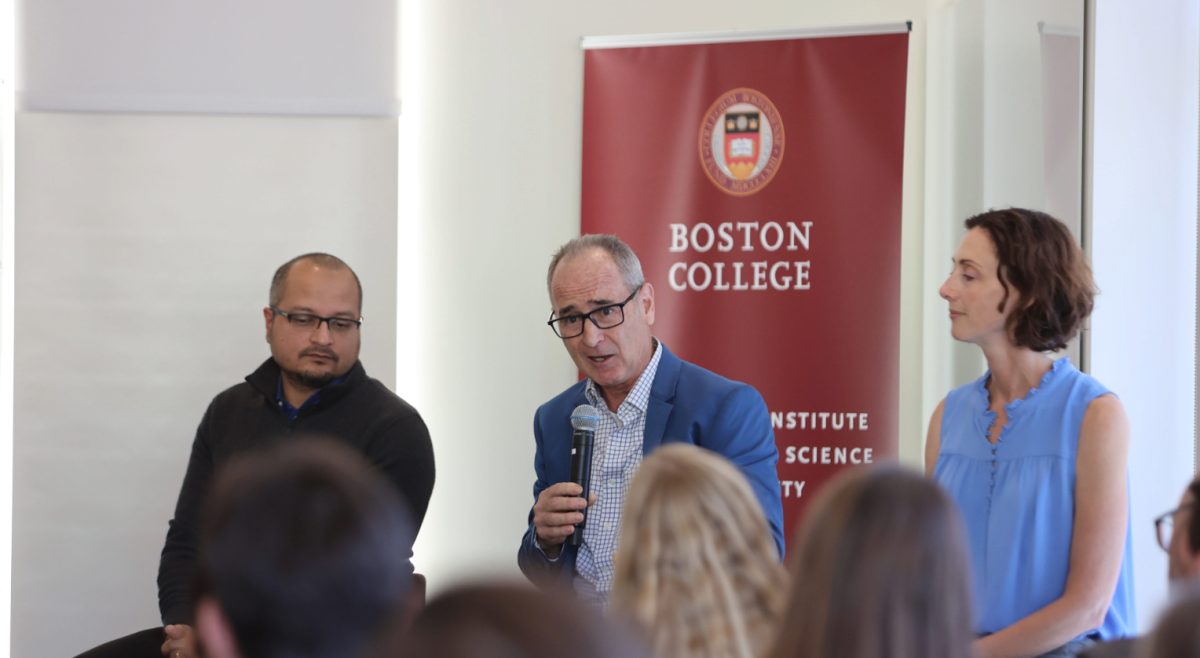
(Paul Criado / Heights Staff)
Climate change impacts far more than just the environment, affecting all aspects of human life, particularly in public health, according to Patrick McGroarty.
“This nexus of climate change and public health has become something that touches all stories these days, and all parts of journalism, and all parts of our lives,” said McGroarty, the economy editor at The New York Times and BC ’06.
McGroarty returned to Boston College on Oct. 1 as the moderator for the first of a four-part series titled “Climate is Every Story,” co-sponsored by the Schiller Institute for Integrated Science, the Institute for the Liberal Arts, the environmental studies department, and the journalism department.
The series aims to discuss how journalists cover the climate crisis and the ways that climate change intersects with everyday life, with the first panel focusing specifically on its connection to public health.
Summer Hawkins, a social epidemiologist and professor at the BC School of Social Work, began the panel by explaining the effects of extreme heat on pregnancy, highlighting what McGroarty called an “unexpected crossover.”
“Looking at the unintended consequences or the groups that are disproportionately affected is such an important area,” Hawkins said. “Our work, and the work here at BC, is really to identify and raise up the voices of marginalized communities so we can identify solutions.”
Praveen Kumar, an associate professor in the School of Social Work, said part of his research on how communities adapt to health outcomes caused by climate change requires examining not only its effects on people’s physical health but also changes in mental health outcomes.
“In South Asia, the summer durations have actually increased from six months all the way to eight or nine months,” Kumar said. “Some of the work that we have been doing in India is essentially to understand the impact of high heat stress on women and children. In addition to physical health, what we’re also trying to understand is the association of high heat stress on mental health.”
From a journalistic perspective, Jason Beaubien, a longtime international correspondent for National Public Radio (NPR), explained how he uses research reports as the foundation for the stories he covers.
“I think that one of the things as a journalist is to try to sift through some of these reports and go, ‘How can I tell that story in a way that’s really going to be engaging?’” Beaubien explained. “And so we went to an outdoor market—me and my translator—and just tried to talk to people about how this affects them.”
Beaubien shared a story about an older man he spoke with in an outdoor market in Baghdad, noting how climate change impacts not only individual health but also a person’s economic status.
“When it gets so hot he can’t work, he doesn’t have air conditioning in his apartment,” Beaubien said. “He both is suffering from whatever health effects of this there are, but there’s also the economic effects on this guy being unable to work in those really hot time periods.”
Kumar also emphasized the intersection of climate and economics, focusing specifically on the stories of rural laborers and farmers.
“Bangladesh is grappling with a lot of seawater rise, urban floods, and the salty water and the seawater getting into farmlands, making them very difficult to farm,” Kumar said. “There is this rural-to-urban displacement that is happening in a big order in Bangladesh, which is climate-induced.”
The discussion then shifted toward possible solutions for climate-induced issues, with Kumar sharing a framework to help communities address these challenges.
“I usually say that as three ‘A’s, which is affordability, accessibility, and awareness,” Kumar said. “There has to be a concordant focus on all of these three.”
Hawkins said the most effective solutions are community-based approaches that do not exacerbate existing disparities. Purchasing air conditioners for those experiencing extreme heat could actually be ineffective and even harmful, she added.
“We’re actually increasing disparities in health,” Hawkins said. “Those that need it most are not able to take up an intervention. We need the individual stories, we need the community-level factors, and I’m here to contribute to say, ‘What are people trying? Is it working?”